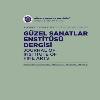Yalancı kelebek [Ricania japonica (Hemiptera: Ricaniidae)]’e karşı bazı kültürel mücadele yöntemlerinin etkisi
Bu çalışma, yaklaşık 10 yılı aşkın Türkiye’nin Doğu Karadeniz Bölgesi’nde önemli bir zararlı olan Ricania japonica (Hemiptera: Ricaniidae)’ya karşı mücadelede uygulanabilecek cultural tedbirleri belirlemek amacıyla 2017-2018 yılları arasında yürütülmüştür. Zararlının bulunduğu bu bölgede başta çay olmak üzere önemli kültür bitkilerinde kimyasal mücadeleyi gerektirecek önemli zararlı bulunmamaktadır. Ancak 2009 yılından itibaren popülasyonu artan bu zararlı özellikle nimf döneminde geleneksel aile ihtiyacına yönelik sebzelerde önemli zararlar yapabilmektedir. Sebze alanlarının çaylıklar ile iç içe olması ve çayda herhangi bir hastalık veya zararlıya karşı sentetik pestisit kullanılmaması alternatif mücadele yöntemlerinden biri olan kültürel mücadeleye yoğunlaşmamıza neden olmuştur. Bu çalışma ile zararlıya karşı cultural mücadelede amacıyla denenen; zararlının yumurtadan çıkmaya başladığı mayıs ayı ortalarına kadar yumurta koyduğu bulaşık bitki materyallerinin imhası, zararlının nymphlerine karşı kaolin, rafine tuz ve kül uygulamalarının zararlının nymphlerine karşı etkileri belirlenmeye çalışılmıştır. Çalışma sonucunda zararlının kışı bulaşık bitkilerde yumurta döneminde geçirmesi nedeniyle bahçelerdeki bulaşık bitkilerin ve bitki atıklarının yok edilmesinin zararlının popülasyonunu yaklaşık %90 azalttığı tespit edilmiştir. Diğer uygulamalar olan kaolin, rafine tuz ve kül uygulamalarının zararlının niflerine karşı etkili olamadıkları belirlenmiştir.
Anahtar Kelimeler:
Kültürel Mücadele, Doğu Karadeniz bölgesi, Ricania japonica
Effect of cultural management methods against fake butterfly [Ricania japonica (Hemiptera: Ricaniidae)]
This study was conducted between 2017 and 2018 to determine the cultural measures that are applied in the control against Ricania japonica (Hemiptera: Ricaniidae), which has caused damage in the Eastern Black Sea Region of Turkey for approximately 10 years as an important pest. Pests are widespread in this region but there is no other important pest that requires significant chemical control in crop plants, in particular tea plants. Furthermore, this pest population, whose population has grown since 2009, may cause significant losses in vegetables especially for traditional family needs during its nymph period. The fact that vegetable fields have been almost interwened with tea plants and synthetic pesticides are not used in tea plant production, has caused us to focus on cultural methods, which are among alternative pest-fighting methods. With this study, the purpose was to determine the effects of kaolin, refined salt and ash applications against the nymphs of the pests, and to investigate how to destroy the infected plant materials in which the pest lay eggs until the middle of May. As a result of the study, it was determined that the destruction of the infected plants and plant wastes in the areas decreased the pest population by 90% because it was the winter months which is the egg-laying period of the pest. Other applications (kaolin, refined salt and ash) were not found effective against the nymphs of this pest.
Keywords:
Cultural Management, Eastern Black Sea Region, Ricania japonica,
___
- Ak K, Güçlü Ş, Sekban R (2013) Doğu Karadeniz Bölgesinde Yeni Bir Zararlı Ricania simulans (Walker, 1851) (Hemiptera: Ricaniidae)’a Karşı Azadirachtin ve Spinosad Etki Maddeli Biyopestisitlerin Etkinliklerinin Belirlenmesi.Tarım Bilimleri Araştırma Dergisi 6 (1): 10-14.Ak K, Güçlü Ş, Eken C, Sekban R (2015) Ricania simulans (Walker, 1851) (Hemiptera: Ricaniidae) a new pest for Turkey. Turkish Journal of Entomology 39(2), 179-186Avidzba NS, Bobokhidze ZM (1982) Biophenology of the Japanese leafhopper. Zashchita Rastenii, No:6, 36 pp.Bostan SZ, Güna K (2014) Hayward (Actinidia deliciosa Planch) Kivi Çeşidinin Meyve Kalitesi Üzerine Rakım ve Yöneyin Etkisi. Akademik Ziraat Dergisi, 3(1), 13-22.Charles JG, Allan DJ (2004) Passionvine hopper, Scolypopa australis (Walker) (Hemiptera: Ricaniidae), egg parasitism by Aphelinidae (Hymenoptera) in New Zealand. New Zealand Entomologist 27: 83-89.Demir E (2009) Ricania Germar, 1818 species of Western Palaearctic Region (Hemiptera: Fulgoromorpha: Ricaniidae). Munis Entomology & Zoology, 4 (1): 271-275Dzhashi VS, Nikolaishvili AA, Demetradze TY (1982) The Japanese leafhopper - a pest of bay. Zashchita Rastenii, No: 2, 57 pp.Engi̇n F (2017) Doğu Karadeniz’de Çay Tarımında Çalışan Gürcü İşçilerin Çalışma Koşulları Üzerine Gözlemler. Fiscaoeconomia, 1(3).Gjonov I (2011) Ricania japonica Melichar, 1898 – a representative of family Ricaniidae (Homoptera, Fulgoromorpha), new to the fauna of Bulgaria. ZooNotes 23, 1-3.Gjonov I, Shishiniova M (2014) Alien Auchenorrhyncha (Insecta, Hemiptera: Fulgoromorpha and Cicadomorpha) to Bulgaria. Bulgarian Journal of Agricultural Science 20, 151-156.Göktürk T, Aksu Y (2014) Morphology, biology and damage of Ricania simulans (Walker) 1851 (Hemiptera: Ricaniidae) which damages in the agriculture and forest areas. Proceedings of the 2nd Symposium of Turkey Forest Entomology and Pathology, 282-285.Göktürk T, Mıhlı A (2015) Doğu Karadeniz Sahil Şeridinin Önemli zararlısı Ricania simulans (Walker,1851) (Hemiptera:Ricaniidae)’ın Mücadelesi Üzerine Araştırmalar.Artvin Çoruh Üniversitesi, Orman Fakültesi Dergisi 16 (1) 89-93.Güçlü Ş, Ak K, Eken C, Akyol H, Sekban R, Beytut B, Yıldırım R (2010) Pathogenicity of Lecanicillium muscarium against Ricania simulans. Bulletin of Insectology 63 (2): 243-246.Güner F, Güney MŞ (2018) Situation Analyses of Hazelnut Sector, The Necessity and Classification of Harvesting Machines. Turkish Journal of Agriculture-Food Science and Technology, 6(9), 1141-1147.Imura O (2003) Herbivorous arthropod community of an alien weed Solanum carolinense L. Appl. Entomol. Zool. 38 (3): 293–300.Logan DP, Allison PA, Stannard K (2002) Selection of Wild Hosts for Feeding by Passion Vine Hopper, Scolypopa australis (Walker) (Hemiptera: Rıcaniidae) in the Bay of Plenty. New Zealand Plant Protection 55:368-373.Mendi AF (2015) Türkiye çay endüstrisi: Sektörel ve ampirik bir çalışma. International Journal of Social Sciences and Education Research, 4(2), 252-274.
- ISSN: 2146-1880
- Yayın Aralığı: Yılda 2 Sayı
- Başlangıç: 2000
- Yayıncı: Artvin Çoruh Üniversitesi Orman Fakültesi
